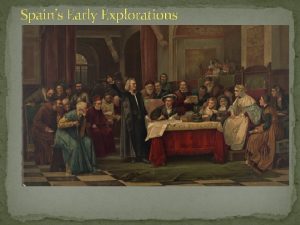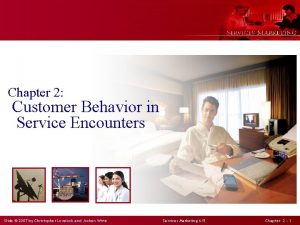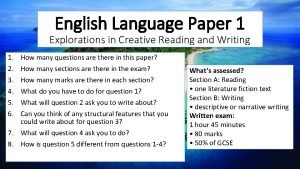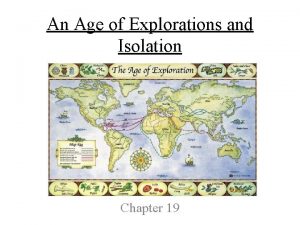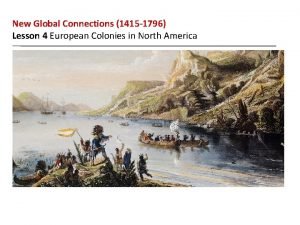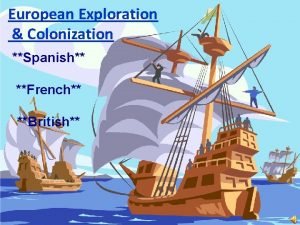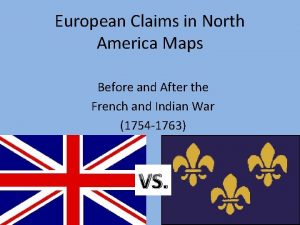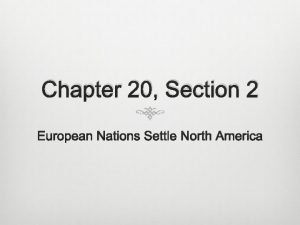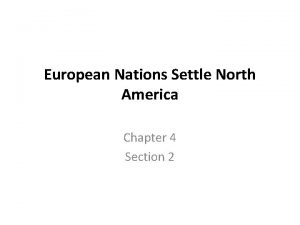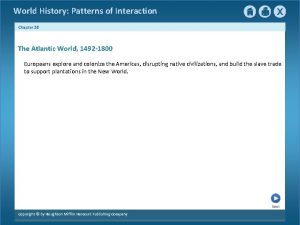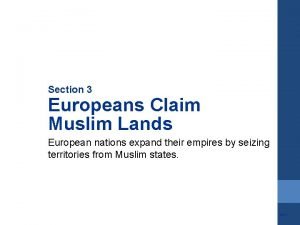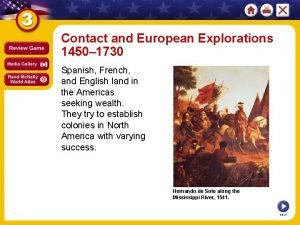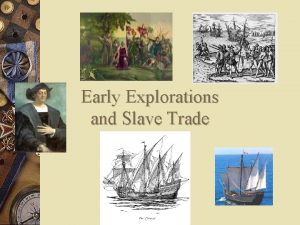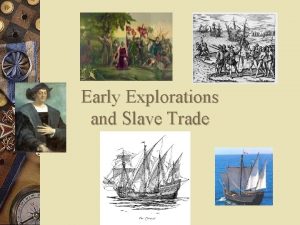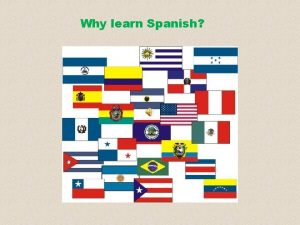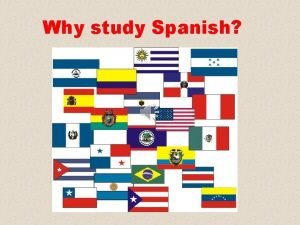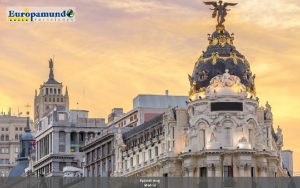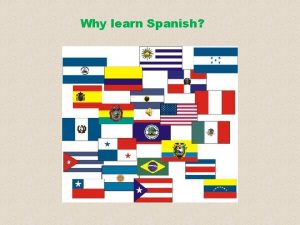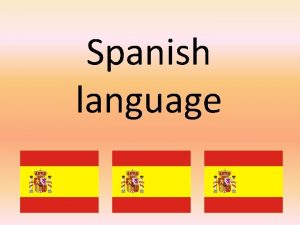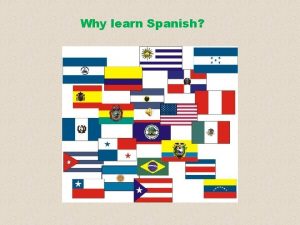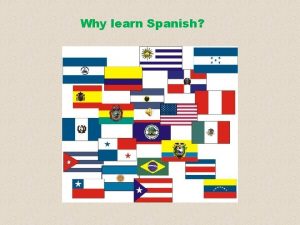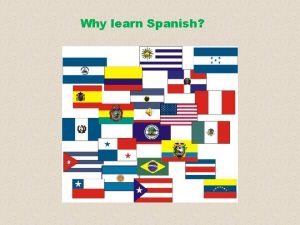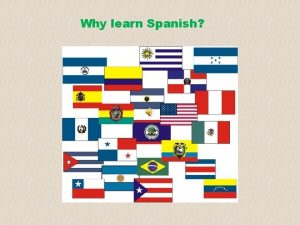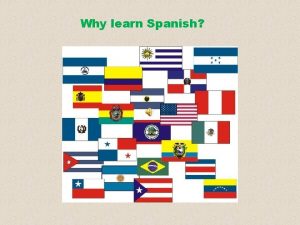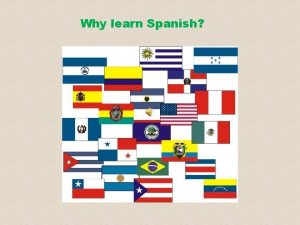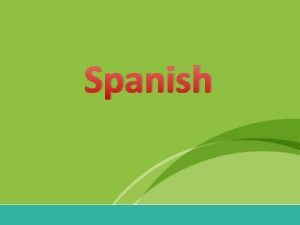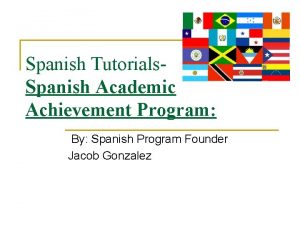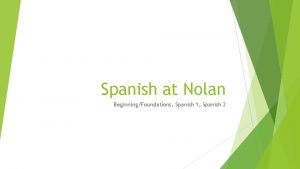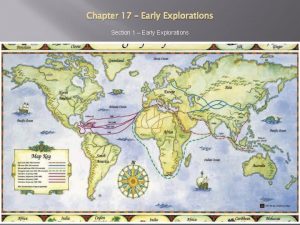Contact and European Explorations Spanish Explorations in North

























- Slides: 25

Contact and European Explorations


Spanish Explorations in North America Renaissance leads to trade • Renaissance means “rebirth” -begins in Italy; 1300 s-1600 s -time of change in learning, art, religion and trade • Trade is mainly between Europe and Asia by eastern land route -merchants suggest shorter sea route

Finding a Water Route to Asia • Portuguese explorers try to sail around Africa to Asia -Vasco da Gama succeeds in 1497 • Christopher Columbus thinks he can sail west across Atlantic to Asia -He finds Americas instead; Spain’s wealth, power increase

Spanish Explorers in the New World • Conquistadors are conquerors, seek to take over existing cultures; do not live peacefully with natives • Coronado, de Soto, Cabrillo expeditions each seek “cities of gold” • Gold never found, treasure stolen from natives, Spain grows richer

Spanish Explorers in Florida • Juan Ponce de León on Columbus’s second voyage, stays in Caribbean • Brutally conquers natives in Puerto Rico, becomes governor • Explores Florida coasts, seeks “fountain of youth, ” never finds it • Discovers Gulf Stream —powerful ocean currents

Other Explorers in the Southeast • Vásquez de Allyón tries to set up Spanish settlement on east coast • First attempt in North Carolina fails • Establishes San Miguel Guadalupe settlement off Georgia coast -lasts less than year; Vásquez de Allyón and most settlers die -survivors leave for Hispaniola

Hernando de Soto • Hernando de Soto enters southwest corner of Georgia in 1540; de Soto goes northeast into Carolinas; first Europeans to cross Appalachian Mts. • Reentered Georgia into Chiefdom of Coosa • De Soto cruel to Native Americans, captures Coosa chief • Southeastern native groups angered, try to destroy expedition • Massacre fails, 2, 500– 3, 000 Native Americans killed in attempt • De Soto heads west but dies soon after, possibly from battle injuries

Hernando de Soto • Only 300 of de Soto’s men survive the expedition • Return to Spain penniless; never find gold • Natives suspicious of Europeans after de Soto -blame explorers for exposure to European diseases • Other Spanish explorers focus efforts in Mexico, South America

A Spanish Colony St. Augustine • 1565, Pedro Menéndez de Avilés tries to keep French out of Florida • Defeats French, builds St. Augustine fort not far from Georgia Spanish Missions in Georgia • Missions —small settlements built around church • Purposes: convert natives to Christianity, keep French off coast • Guale mission district covers Outer Coastal Plain, barrier islands • Spanish control coast and southern Georgia for over 100 years

French Explorations in North America • France hopes to gain riches, freedom by peaceful colonization • Sends Jean Ribault in 1562 to establish colony on Atlantic coast -travels with Lieutenant René de Laudonnière, 150 settlers • Settlers are Huguenots—French Protestants wanting religious freedom

A Failed Attempt by Ribault • Ribault lands in Florida, goes north, builds Fort Caroline • Ribault and de Laudonnière must return to France for supplies • French religious war prevents aid; Ribault asks England for help, but is imprisoned by Queen Elizabeth until 1565

René de Laudonnière • René de Laudonnière, 304 Huguenots return to Florida, 1564 • Group builds Fort Caroline near present-day Jacksonville • De Laudonnière friendly with natives until supplies run out • Some colonists lose faith in leadership, turn to piracy • De Laudonnière, colony wait for France to help

Conflict with Spain • Ribault released from prison, sent to rescue Fort Caroline • Spain’s King Phillip II angered by French in Florida territories -sends Pedro Menéndez de Avilés, warships to defeat colony • 500 men destroy Fort Caroline; Ribault killed -de Laudonnière wounded; escapes, writes history of event -France ends colonization of southeastern North America

New France • English settle coast of North America; France explores interior • By late 1600 s French claim Ohio, Mississippi valleys; Great Lakes • French Louisiana runs from Appalachians to Rockies • New France colony has 80, 000 people by 1760 • French control most land in interior of North America

Early English Colonies in North America • Catholic Spain, Protestant England clash over religion • English navy defeats powerful Spanish Armada (1588) -England remains Protestant, Spain no longer major power • English challenges Spanish claims in North America

Conditions in England • Poor conditions in England: cities overcrowded, food shortages • Colonization seen as solution to overcrowding, boost to economy • Colonies become market for English exports; provider of raw materials • Transfer of wealth from colony to parent country called mercantilism

The Roanoke Colonies • Sir Walter Raleigh funds colony on Roanoke Island, Virginia (1585) • Food supplies run out; survivors return to England the next year • Second try at Roanoke colony in 1587; John White named governor • White goes to England for supplies, returns in 1590; colonists gone -colonists may have joined nearby tribes, or relocated and died -known as the Lost Colony

A Colony at Jamestown • English learn that one person cannot finance entire colony • Joint-stock companies formed to raise money for projects -investors back company, receive stock shares, split profits or losses • Virginia Companies of London, Plymouth obtain charters in 1606 -charters—written contracts giving holder rights to set up colony

A Difficult First Year • Virginia Company of London sets up Jamestown in 1607; 100 colonists • Climate, malaria, inefficiency take toll, 38 alive January, 1608 • John Smith has wall built around colony, trades food with Powhatans • Colony survives, 800 more colonists arrive in 1609


Tobacco Changes Jamestown • John Rolfe develops easy-growing tobacco; popular in England • Virginia Company offers 50 acres to those who can pay own passage • Indentured servants —sell labor to person who pays their passage -work for set number of years, then free to set up own farm or trade • First enslaved Africans brought to Jamestown in 1619 (for tobacco) • Population of colony 2, 000 by 1621

Other Early English Colonies • Carolina founded 1663, Charles Town (later Charleston) in 1670 • Charles Town becomes Huguenot refuge in 1685 • English use trails through Georgia to raid Spanish forts in Florida • Spanish attack Charles Town but are defeated, retreat to Florida • Creek trade with English, fight tribes who side with Spain

The Yamasee War • France, Spain lose power, England dominates trade in colonies • English hold monopoly—control prices of all goods, supplies • Native Americans cheated; Yamasee tribe leads uprising (1715) • Other tribes join; traders killed; settlers flee to Charles Town • English regroup, push Yamasee to Florida; Creek retreat to Alabama

Plans for a Georgia Colony • English want Carolina plantations protected, fear Spanish in Florida • Need to colonize land between Spanish Florida, English Carolina • Scottish nobleman Sir Robert Montgomery proposes colony • 1717, Margravate of Azilia colony planned in present-day Georgia • Charter lost 3 years later; English wary of dangers of settling land
 Spanish explorations
Spanish explorations Noncontact force examples
Noncontact force examples Which of the following is sliding contact bearing
Which of the following is sliding contact bearing Need a service chapter 2
Need a service chapter 2 Contact and non contact forces
Contact and non contact forces Air resistance contact force
Air resistance contact force What is non contact force
What is non contact force Contact vs field forces
Contact vs field forces Dermatitis atopica icd 10
Dermatitis atopica icd 10 Air resistance contact or noncontact
Air resistance contact or noncontact Ohmic contact
Ohmic contact Explorations in creative reading and writing
Explorations in creative reading and writing Explorations in creative reading and writing
Explorations in creative reading and writing Chapter 19 an age of explorations and isolation
Chapter 19 an age of explorations and isolation Great explorations in math and science
Great explorations in math and science North east and north cumbria integrated care system
North east and north cumbria integrated care system Lesson quiz 14-1 north and south
Lesson quiz 14-1 north and south European colonies in north america
European colonies in north america Spanish settlements in north america
Spanish settlements in north america European land claims in north america map
European land claims in north america map European nations settle north america chapter 20 section 2
European nations settle north america chapter 20 section 2 European nations settle north america
European nations settle north america Chapter 20 section 4 world history
Chapter 20 section 4 world history Europeans claim muslim lands
Europeans claim muslim lands Chapter 20 section 2 european nations settle north america
Chapter 20 section 2 european nations settle north america Conceptual integrated science explorations
Conceptual integrated science explorations
